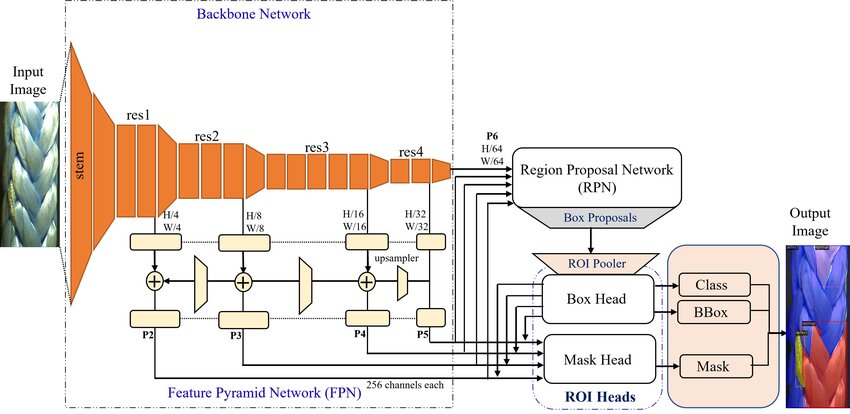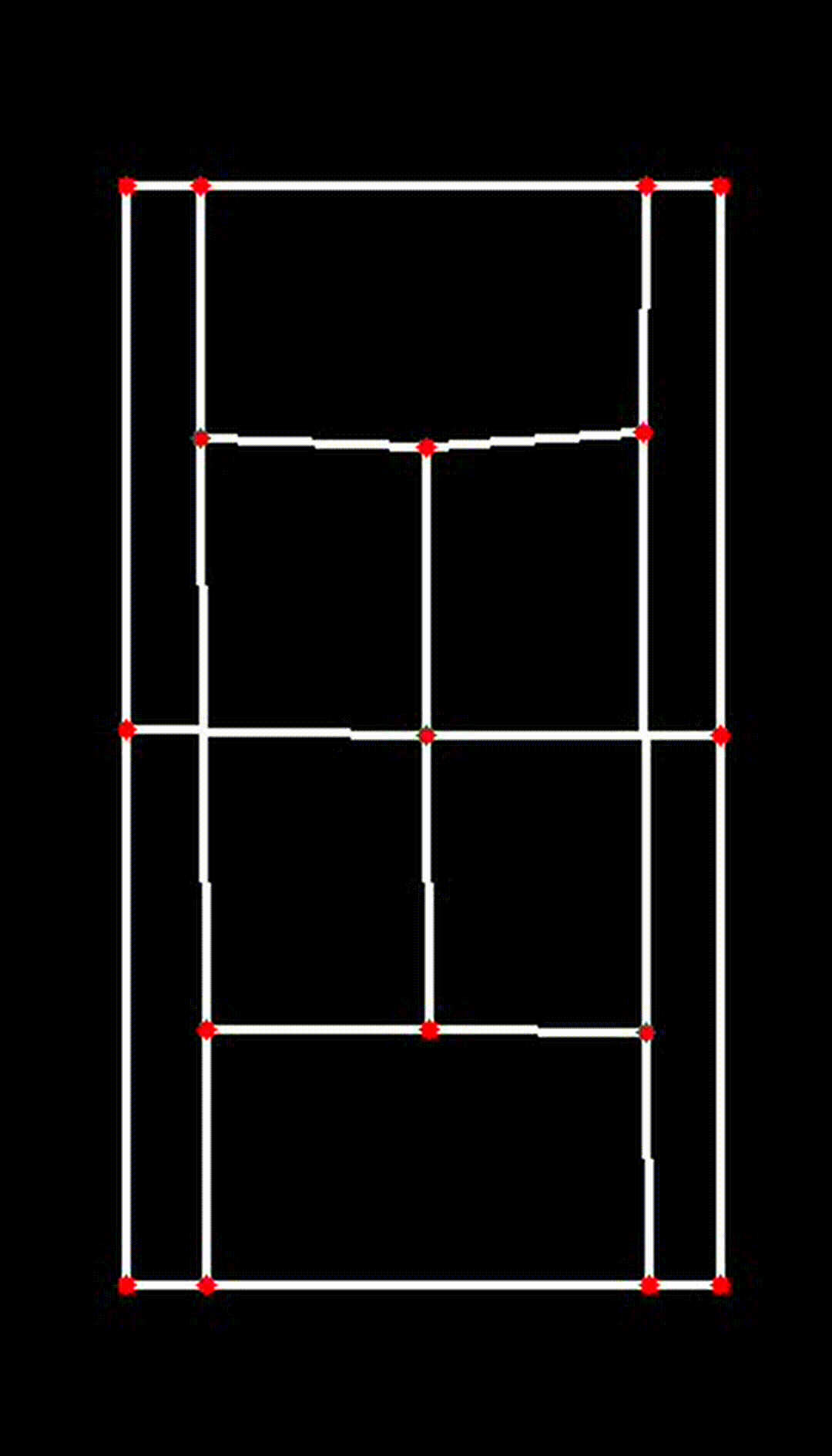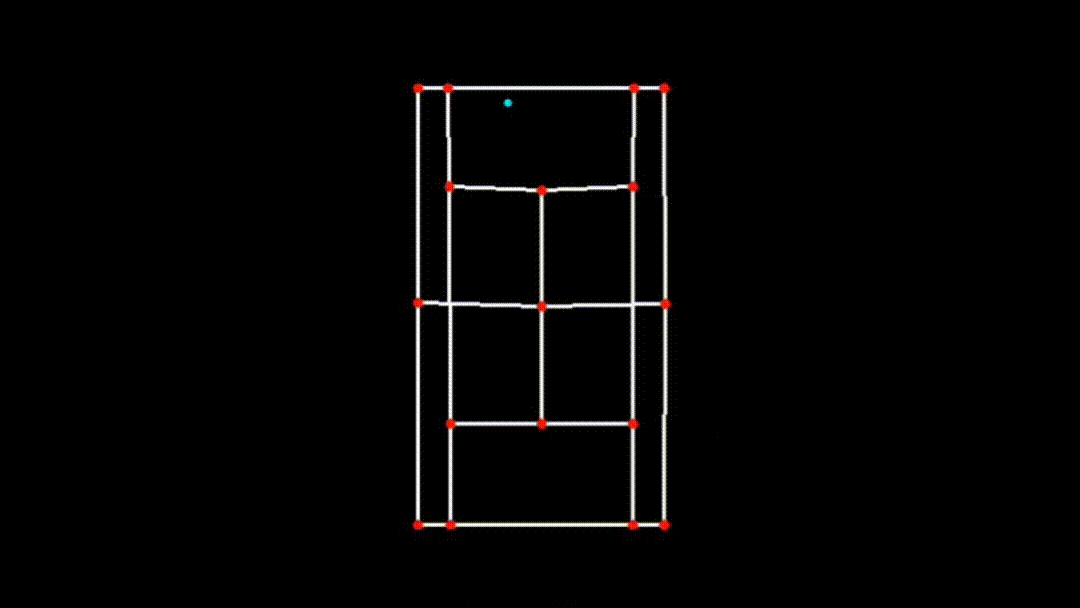🏁 Automate tennis match analysis using the power of computer vision.
CourtCheck leverages advanced computer vision techniques to accurately track tennis ball movements and court boundaries in tennis matches. This project aims to provide real-time insights and automated decision-making in tennis, reducing human error and enhancing the accuracy of in/out calls. CourtCheck integrates Python, machine learning, and computer vision to create a seamless and efficient system for tennis match analysis.
🔑 Process & Key Features
🔎 Court Detection
CourtCheck employs keypoint detection algorithms to identify and track the tennis court's boundaries, ensuring accurate mapping and analysis of the court's dimensions.
📑 Annotation
We began by annotating images using OpenCV in the COCO format, generating JSON files for each annotated image. The OpenCV Annotation Tool provides an excellent interface for image annotation and export in various formats. It also features an interpolation tool that allows the use of a skeleton to label key frames, which can be interpolated over consecutive frames in the video.
You can find the annotations here.
Each label in the skeleton represents a keypoint on the tennis court, identifying an important corner or intersection of lines that are crucial for the overall court detection when training the model. Here are the keypoints and their corresponding labels:
| Keypoint | Label | Keypoint | Label | Keypoint | Label |
|---|---|---|---|---|---|
| BTL | Bottom Top Left | ITM | Inner Top Middle | ITR | Inner Top Right |
| BTLI | Bottom Top Left Inner | IBR | Inner Bottom Right | NL | Net Left |
| BTRI | Bottom Top Right Inner | NR | Net Right | BBL | Bottom Bottom Left |
| BTR | Bottom Top Right | NM | Net Middle | IBL | Inner Bottom Left |
| BBR | Bottom Bottom Right | ITL | Inner Top Left | IBM | Inner Bottom Middle |
| BBRI | Bottom Bottom Right Inner | BBLI | Bottom Bottom Left Inner |
🤖 Training the Model
We utilized the A100 Nvidia GPU on Google Colab to train our Detectron2 model on different types of datasets. These datasets included varying court surfaces and slightly different camera angles to ensure robustness and generalizability of the model. Below, we explain the process and provide the code used for training the model incrementally with mixed datasets.
Below is an overview of the Detectron2 architecture:

We used the COCO-Keypoints/keypoint_rcnn_R_50_FPN_3x.yaml configuration file because it is specifically designed for keypoint detection tasks. The keypoint_rcnn_R_50_FPN_3x.yaml configuration is well-suited for this task because it includes a pre-trained ResNet-50 backbone that provides strong feature extraction capabilities, coupled with a Feature Pyramid Network (FPN) that helps detect objects at multiple scales. This combination ensures that the model can accurately identify and track the key points on the tennis court, providing precise court boundary detection and enabling accurate in/out call determinations.
🧬 Model Code
The code below sets up and trains the Detectron2 model using multiple datasets:
- Dataset Registration: Registers the training and validation datasets.
- COCO Instance Registration: Registers the datasets in COCO format.
- Metadata Configuration: Configures metadata for keypoints, keypoint flip map, and skeleton.
- Configuration Setup: Sets up the model configuration, including dataset paths, data loader workers, batch size, learning rate, maximum iterations, learning rate decay steps, and checkpoint period.
- Trainer Initialization and Training: Initializes a custom trainer and starts or resumes the training process.
You can find the Google Colab Notebook here.
# Function to set up and train the model with mixed datasets incrementally
def train_model(max_iter, resume=False):
register_datasets(train_json_files, train_image_dirs, "tennis_game_train")
register_datasets(val_json_files, val_image_dirs, "tennis_game_val")
register_coco_instances(f"tennis_game_train", {}, train_json_files, train_image_dirs)
register_coco_instances(f"tennis_game_val", {}, val_json_files, val_image_dirs)
MetadataCatalog.get(f"tennis_game_train").keypoint_names = keypoint_names
MetadataCatalog.get(f"tennis_game_train").keypoint_flip_map = keypoint_flip_map
MetadataCatalog.get(f"tennis_game_train").keypoint_connection_rules = skeleton
MetadataCatalog.get(f"tennis_game_val").keypoint_names = keypoint_names
MetadataCatalog.get(f"tennis_game_val").keypoint_flip_map = keypoint_flip_map
MetadataCatalog.get(f"tennis_game_val").keypoint_connection_rules = skeleton
cfg = get_cfg()
cfg.merge_from_file("/content/drive/MyDrive/ASA Tennis Bounds Project/models/court_detection_model/detectron2/configs/COCO-Keypoints/keypoint_rcnn_R_50_FPN_3x.yaml")
cfg.DATASETS.TRAIN = tuple([os.path.basename(f).split('.')[0] for f in train_json_files])
cfg.DATASETS.TEST = tuple([os.path.basename(f).split('.')[0] for f in val_json_files])
cfg.DATALOADER.NUM_WORKERS = 4
cfg.SOLVER.IMS_PER_BATCH = 4 # Increase if you have more GPU memory
cfg.SOLVER.BASE_LR = 0.0001 # Lower learning rate for more careful training
cfg.SOLVER.MAX_ITER = max_iter # Total number of iterations
cfg.SOLVER.STEPS = [int(max_iter*0.75), int(max_iter*0.875)] # Decay learning rate
cfg.SOLVER.GAMMA = 0.1 # Decay factor
cfg.SOLVER.CHECKPOINT_PERIOD = 20000 # Save a checkpoint every 20000 iterations
cfg.MODEL.ROI_HEADS.BATCH_SIZE_PER_IMAGE = 256 # Increase for more stable gradients
cfg.MODEL.ROI_HEADS.NUM_CLASSES = 11 # Your dataset has 11 classes
output_dir = f"/content/drive/MyDrive/ASA Tennis Bounds Project/models/court_detection_model/detectron2/game_model"
cfg.OUTPUT_DIR = output_dir
os.makedirs(cfg.OUTPUT_DIR, exist_ok=True)
trainer = TrainerWithEval(cfg)
trainer.resume_or_load(resume=resume)
trainer.train()
# Training parameters
custom_iter = 50000 # Adjust this to your custom number of iterations per session
max_iter = last_iter + custom_iter # Change this for the number of iterations per session
# Execute to train model
train_model(max_iter, resume=True)📽️ Post Processing
After training the model, the next crucial step is post-processing the results to ensure accurate and meaningful outputs. Post-processing involves refining the model's predictions and visualizing the detected key points on the tennis court for better interpretation and analysis.
To visualize the court, we draw polylines between key points that align with the court lines and boundaries. These lines help in creating a clear and precise representation of the tennis court structure. Here are the specific polylines to be drawn:
lines = [
("BTL", "BTLI"), ("BTLI", "BTRI"), ("BTL", "NL"), ("BTLI", "ITL"),
("BTRI", "BTR"), ("BTR", "NR"), ("BTRI", "ITR"), ("ITL", "ITM"), ("ITM", "ITR"),
("ITL", "IBL"), ("ITM", "NM"), ("ITR", "IBR"), ("NL", "NM"), ("NL", "BBL"),
("NM", "IBM"), ("NR", "BBR"), ("NM", "NR"), ("IBL", "IBM"),
("IBM", "IBR"), ("IBL", "BBLI"), ("IBR", "BBRI"), ("BBR", "BBRI"),
("BBRI", "BBLI"), ("BBL", "BBLI"),
]The visualize_predictions function is essential for visualizing model predictions on an input image. Here are two key parts of the function:
outputs = predictor(img)
v = Visualizer(
img[:, :, ::-1],
metadata=MetadataCatalog.get("tennis_game_train"),
scale=0.8,
instance_mode=ColorMode.IMAGE,
)
instances = outputs["instances"].to("cpu")
if len(instances) > 0:
max_conf_idx = instances.scores.argmax()
instances = instances[max_conf_idx : max_conf_idx + 1]
out = v.draw_instance_predictions(instances)
keypoints = instances.pred_keypoints.numpy()[0]This part of the function generates predictions from the model and selects the instance with the highest confidence score. The keypoints of this instance are extracted for further processing.
To ensure that the detected key points on the tennis court are stable and less jittery, especially when dealing with video frames, we use a stabilization technique. This involves averaging the positions of detected key points over a history of frames.
Key Point History Initialization
keypoint_history = {name: deque(maxlen=10) for name in keypoint_names}We initialize a dictionary called keypoint_history where each key is a key point name, and the value is a deque (double-ended queue) with a maximum length of 10. This deque will store the positions of each key point over the last 10 frames.
Stabalizing Keypoints
def stabilize_points(keypoints):
stabilized_points = []
for i, keypoint in enumerate(keypoints):
keypoint_history[keypoint_names[i]].append(keypoint[:2])
if len(keypoint_history[keypoint_names[i]]) > 1:
stabilized_points.append(
np.mean(np.array(keypoint_history[keypoint_names[i]]), axis=0)
)
else:
stabilized_points.append(keypoint[:2])
return np.array(stabilized_points)The stabilize_points function then uses the keypoint_history dictionary to process the detected key points and reduce jitter by averaging their positions over the last 10 frames. For each detected key point, its position is appended to the corresponding deque in the keypoint_history dictionary. If the deque contains more than one position, the average of these positions is computed and added to the stabilized_points list. If the deque contains only one position, the key point is added to the list as is. This results in more consistent and smooth key point positions for further processing and visualization.
Visualizing and Transforming the Court
To visualize the tennis court and transform it into a 2D plane, the following steps are taken:
-
Court Detection in the Main Frame:
- The model detects key points on the tennis court in the main video frame.
- Polylines are drawn between these key points to visualize the court lines and boundaries clearly, as shown in the first image.
-
Transformation to Black and White and 2D Plane:
- The detected court is then converted into a black-and-white image to simplify the structure.
- This black-and-white image is transposed into a 2D plane, providing a clear and concise representation of the tennis court, as depicted in the second image.
| Transposed 2D Plane |
|---|
 |
Transforming Key Points
The transform_points function is designed to transpose the detected key points to fit within a defined black frame. This transformation ensures that the court is displayed correctly in a 2D plane. Below is an explanation of the function, broken down into its important parts:
Function Explanation
def transform_points(keypoints, black_frame_width, black_frame_height):
width_frac = 6
height_frac = 7The function takes in the key points, the width, and the height of the black frame. It uses fractions to determine the relative positions within the frame.
src_points = np.array(
[
keypoint_dict["BTL"],
keypoint_dict["BTR"],
keypoint_dict["BBL"],
keypoint_dict["BBR"],
],
dtype=np.float32,
)The destination points are defined within the black frame for the four corners of the court: BTL (Bottom-Top-Left), BTR (Bottom-Top-Right), BBL (Bottom-Bottom-Left), and BBR (Bottom-Bottom-Right). These points are used to establish the skeleton of the court within the black frame.
matrix = cv2.getPerspectiveTransform(src_points, dst_points)
transformed_keypoints = cv2.perspectiveTransform(keypoints[None, :, :2], matrix)[0]
return transformed_keypoints, matrixUsing OpenCV's getPerspectiveTransform, a transformation matrix is calculated to map the source points to the destination points. The perspective transformation is then applied to the key points, fitting them into the black frame for a top-down 2D view.
🎾 Ball Tracking
CourtCheck is integrated with a ball tracking model called TrackNet. TrackNet is an advanced deep learning model specifically designed for tracking tennis balls, and it has been instrumental in enhancing the overall functionality of this project. The TrackNet model used here is adapted from yastrebksv's TrackNet implementation on GitHub.
↔️ Integration Process
The integration of court detection with TrackNet involves the following steps:
-
Court Detection: First, the court detection model processes each frame of the video to identify and map the court's key points. This ensures that the court is accurately detected and transformed into a 2D plane.
-
Ball Tracking with TrackNet: The TrackNet model is then applied to the same frames to detect and track the tennis ball. TrackNet's robust tracking capability allows for precise ball movement analysis throughout the video.
-
Combining Results: The results from both models are combined to provide a comprehensive visualization of the tennis game. This includes the detected court and the tracked ball, offering insights into ball positions relative to the court boundaries.
The combine_results function in process_video.py integrates the outputs from court_detection.py and ball_detection.py to process each video frame and produce the final visualization.
Here are a couple key steps of the function
-
Court Detection:
outputs = court_predictor(frame) instances = outputs["instances"] if len(instances) > 0: keypoints = instances.pred_keypoints.cpu().numpy()[0] keypoints_found += 1 processed_frame = visualize_predictions(frame, court_predictor, keypoint_names, lines, black_frame_width, black_frame_height) else: keypoints = np.zeros((17, 3)) processed_frame = frame.copy()The court detection model is applied to the current frame. If keypoints are found, they are visualized on the frame; otherwise, the frame is copied as is.
-
Ball Tracking:
x_pred, y_pred = detect_ball(tracknet_model, device, frame, prev_frame, prev_prev_frame) ball_track.append((x_pred, y_pred))The TrackNet model is used to detect the ball's position in the current frame, and the position is added to the
ball_tracklist. -
Visualizing Ball Movement:
if x_pred and y_pred: for j in range(min(7, len(ball_track))): if ball_track[-j][0] is not None and ball_track[-j][1] is not None: if 0 <= int(ball_track[-j][0]) < processed_frame.shape[1] and 0 <= int(ball_track[-j][1]) < processed_frame.shape[0]: cv2.circle(processed_frame, (int(ball_track[-j][0]), int(ball_track[-j][1])), max(2, 7 - j), (255, 255, 0), -1)The detected ball positions are visualized on the frame, drawing circles to represent the ball's trajectory.
-
Stabilizing and Transforming Key Points:
stabilized_points = stabilize_points(keypoints) transformed_keypoints, matrix = transform_points(stabilized_points, black_frame_width, black_frame_height) court_skeleton = visualize_2d(transformed_keypoints, lines, black_frame_width, black_frame_height)Key points are stabilized and transformed to fit within a defined black frame, and the court skeleton is visualized.
-
Transforming Ball Position to 2D Plane:
if x_pred and y_pred: ball_pos_2d = transform_ball_2d(x_pred, y_pred, matrix) if 0 <= int(ball_pos_2d[0]) < court_skeleton.shape[1] and 0 <= int(ball_pos_2d[1]) < court_skeleton.shape[0]: cv2.circle(court_skeleton, (int(ball_pos_2d[0]), int(ball_pos_2d[1])), 3, (255, 255, 0), -1)The ball's position is transformed into the 2D plane of the court skeleton and visualized.

-
Combining and Storing the Processed Frame:
processed_frame[0 : court_skeleton.shape[0], 0 : court_skeleton.shape[1]] = court_skeleton combined_frames.append(processed_frame)The court skeleton is overlaid onto the processed frame, and the frame is added to the list of combined frames.
The combine_results function effectively integrates court detection and ball tracking to produce a comprehensive visualization of the tennis game, showing both the court and the ball's movement in each frame.
Crediting TrackNet
The TrackNet model used in this project is credited to yastrebksv. Their implementation provided the foundation for the ball tracking functionality integrated into this project.
🪴 Areas of Improvement
- Accuracy: Enhance the accuracy of ball and court detection to ensure reliable analysis.
- Real-Time Processing: Implement real-time video feed analysis for instant decision-making during matches.
- Automatic Court Detection: Automate the court detection process to handle different court types and angles without manual input.
- Player Tracking: Integrate player tracking to provide comprehensive match statistics and insights.
🚀 Further Uses
- Match Analytics: Utilize the system for detailed match analytics, including player performance and shot accuracy.
- Training and Coaching: Provide coaches and players with valuable data to improve training sessions and match strategies.
- Broadcast Enhancement: Enhance sports broadcasting with real-time analysis and insights for viewers.
💻 Technology
- OpenCV: For image and video processing.
- Detectron2: For keypoint detection and court boundary identification.
- TrackNet: For tennis ball detection and tracking.
- NumPy: For numerical computations and data manipulation.
- PyTorch: For building and training machine learning models.
- tqdm: For progress bar visualization in loops and processing tasks.
🛠️ Installation
To set up the project, clone the repository and install the dependencies using the requirements.txt file:
git clone https://github.com/AggieSportsAnalytics/CourtCheck.git
cd CourtCheck
pip install -r requirements.txtAfter installing the requirements, navigate to the scripts/process_video.py directory. At the bottom of the script, update the video paths to your desired input and output locations:
video_path = "..." # Input Video Path (mp4 format)
output_path = "..." # Output Video Path (mp4 format)⚠️ Note: This process is for post-processing, meaning it will infer on a video input to detect the court and the ball. This operation is intensive on computer hardware and may take quite a bit of time to complete. If you want to use Google Colab's online GPU/processor instead, then head to Google Colab Notebook. Make sure to run all cells in chronological order.